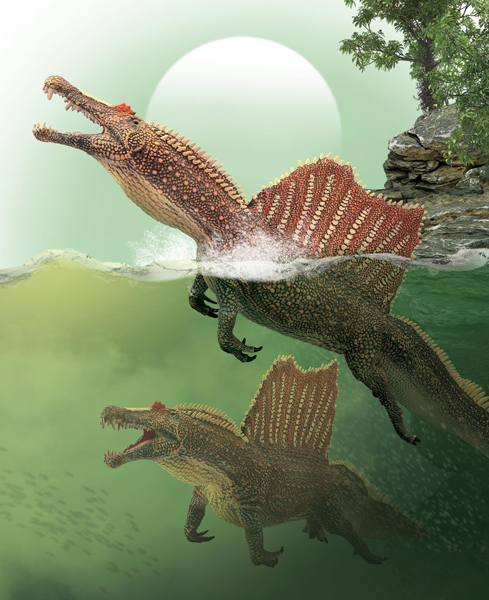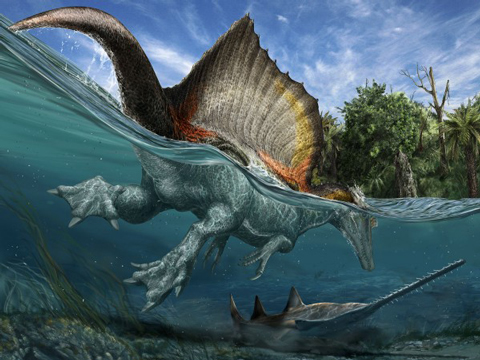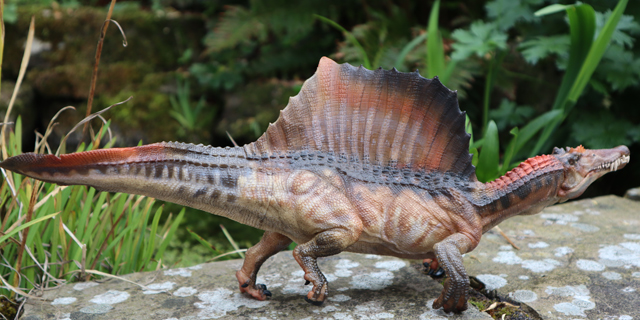Spinosaurus Research – Inferring the Lifestyle of a Huge Theropod Dinosaur
Recently, Everything Dinosaur team members wrote a blog post summarising the findings of the latest scientific paper on Spinosaurus aegyptiacus. This paper (Myhrvold et al), outlined some drawbacks in using bone density analysis to infer an extinct animal’s habits and lifestyle. They outlined some errors and omissions in a previous study that concluded Spinosaurus and Baryonyx walkeri, were capable of submerging and hunting underwater.

An Extensively Studied Theropod
Named and described in 1915 (Stromer), Spinosaurus aegyptiacus has been the subject of intense research over the last decade. It was perhaps the longest theropod dinosaur of all. Some palaeontologists have estimated that S. aegyptiacus was up to fifteen metres long. Its mode of hunting and behaviour has come under detailed scrutiny since a detailed description, based on new fossil material was published in 2014.
This paper proposed that Spinosaurus was a semi-aquatic, obligate quadruped.
To read Everything Dinosaur’s 2014 blog post: Spinosaurus – Four Legs are Better than Two.

A Shoreline Stalker or an Underwater Predator?
Palaeontologists continued to debate whether Spinosaurus aegyptiacus and its near relatives were underwater predators, or shoreline stalkers. The 2014 research paper proposed that although Spinosaurus was a capable swimmer it was not a fully aquatic, underwater predator.
However, in 2020 a paper published in the journal Nature described Spinosaurus caudal vertebrae. These bones suggested that S. aegyptiacus had a broad tail. This could be used to propel itself through the water.
To read Everything Dinosaur’s 2020 post: Spinosaurus The River Monster.

Picture credit: Everything Dinosaur
The picture (above) shows the Papo limited-edition Spinosaurus aegyptiacus figure. This model depicts Spinosaurus as a quadruped and emphasises the broad, deep tail.
To view the range of Papo figures in stock: Papo Prehistoric Animal Figures.
However, in 2022 a scientific paper was published in the journal “eLife” that challenged the aquatic lifestyle. Palaeontologists led by scientists from the University of Chicago argued that Spinosaurus and Baryonyx walkeri would have been unstable when surface swimming. They also concluded that these dinosaurs would be too buoyant to dive and remain fully submerged.
Everything Dinosaur’s blog post covering this research: Spinosaurus Not an Aquatic Dinosaur.
Dense Bones Acting Like Ballast
Also, in 2022 another assessment using a statistical analysis of bone density proposed that Spinosaurus could dive and stay submerged (Fabbri et al). The heavy bones acted like ballast. This anatomical adaptation is seen in extant birds such as penguins and also in some mammals like manatees. These researchers also argued that some other spinosaurids, such as Suchomimus lacked these dense bones and were probably waders.
The blog post covering this research: Bone Density Study Proposes Some Spinosaurids were Fully Aquatic.
The new study (Myhrvold et al), criticised the complex statistical methodology (pFDA) used in the bone density study. The team concluded that the study undertaken by Fabbri et al had measurement errors and was flawed. It was not possible to infer an aquatic habit for spinosaurids based on this data.
To read Everything Dinosaur’s article on the research by Myhrvold et al: Back to the Shore for Spinosaurus.
The researchers demonstrated that it is important to use consistent and objective criteria to decide which species to include and exclude, as well as how to classify their behaviour. The findings also demonstrate the importance of taking measurement errors and individual variations into account when assessing bone density.
The debate over the lifestyle and habits of spinosaurids is likely to continue. We look forward to the next instalment in this long-running debate.
Visit the Everything Dinosaur website: Everything Dinosaur.

